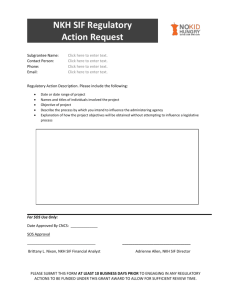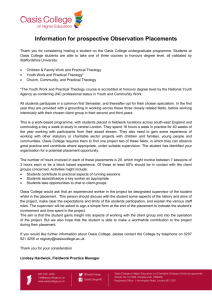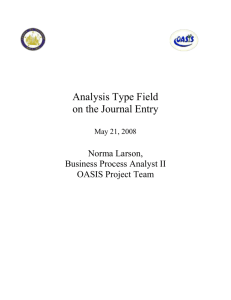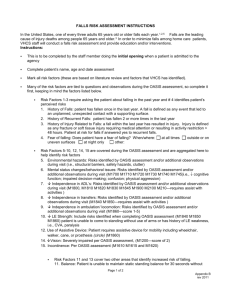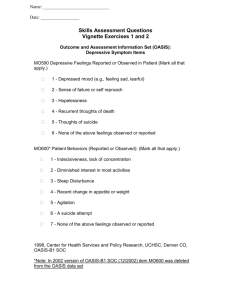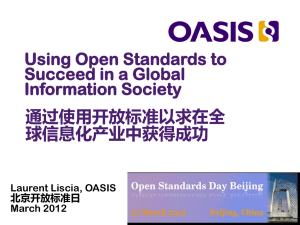Differences between OASIS Data Model and CEN/ISSS PT Data
advertisement
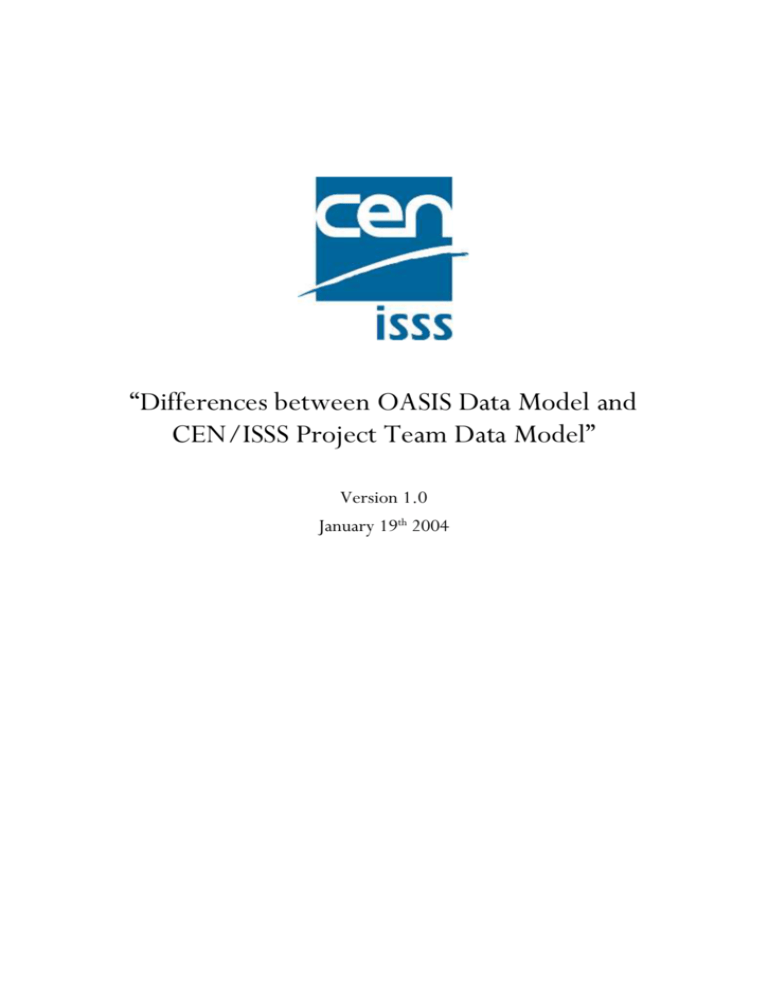
“Differences between OASIS Data Model and CEN/ISSS Project Team Data Model” Version 1.0 January 19th 2004 Contents 1 COMPARISON BETWEEN BOTH DATA MODELS ....................................................................... 3 1.1 COMMON ELEMENTS .......................................................................................................................... 3 1.2 FOOD SERVICES OBJECT ..................................................................................................................... 4 1.3 HUMAN RESOURCES & FINANCIALS OBJECTS .................................................................................... 5 1.4 LIBRARY OBJECT ................................................................................................................................ 5 1.5 STUDENT, STAFF PERSONAL AND SCHOOL INFORMATION OBJECTS .................................................... 5 1.5.1 School Information..................................................................................................................... 5 1.5.2 Student Information ................................................................................................................... 5 1.5.3 Staff Personal Information ......................................................................................................... 6 1.5.4 Student Curriculum and Gradebook information ...................................................................... 6 1.6 TRANSPORTATION INFORMATION ....................................................................................................... 6 2 1 Comparison between both Data Models The CEN/ISSS Project Team has developed three versions of its document “Adaptation of SIF Data Model to a European context” before it become final and has also developed a document based on the Data Model generated by the OASIS group, “OASIS Data Model”. Both the OASIS version and the CEN PT version are based on the SIF Data Model with some updates to cope with the specific European needs. Many of the changes by the CEN/ISSS/WS/LT Project Team had been done using the recommendations in the CWA “Internationalisation of SIF and harmonisation with other specs/standards”. This document identified those elements that should be extended in order to be used in a worldwide context. In this particular case only the things necessary to cope with a European context have been taken into account. CEN/ISSS/WS/LT PT’s and OASIS’s data models have some differences: 1.1 Common Elements OASIS common elements are exactly the same as SIF whereas this PT has defined four new elements: DateTime: SIF Data Model does not specify how dates should be represented. The first recommendation could be to explicitly define the date format in the conceptual data model with a widely used standard like ISO 8601:2000, i.e. in the form YYYY-MM-DD. As SIF is to be used in multicultural environments an extended solution should be found. Although the format proposed above assures interoperability, other national formats for dates or Eras (reference points) are not taken into account. The suggestion is to include an additional local Date that corresponds to the DateTime in ISO 8601:2000 format whenever possible. Provided there exists a unique format/era reference, localisation would be identified using the country code (using ISO 3166-1:1997 and ISO 31663:1999). This also supports different formats to represent dates (e.g. DD-MM-YYYY). Nevertheless, since there may be some cases where the country identifier is not enough, an additional reference to the standard document where the format is specified could be needed. In order to ensure interoperability in a multicultural environment the ISO 8601:2000 standard could be used as the canonical form to represent dates. The alternative representation proposed here should be used whenever providing a localised reference point in time is especially relevant. This way, this object is used to represent a date, a time or both including the time zone. DMESINumber: This is a new object which is used to specify the format of numbers. The agreement for representing decimal numbers and thousands may be different in the different European countries. Several countries use a point to separate the integer part from the decimal one while other countries use a comma. The same thing occurs to separate thousands. The solution adopted was to propose a canonical representation together with the option to represent different localized representations. Measurement: Some of the measures expressed in the SIF specification do not have the unit. This is a new object that solves this situation by making an aggregate object with three sub-elements: an identifier of the unit, an identifier of the country where the measurement is done and the value. 3 MonetaryAmount: In SIF there were several references to money but no indication of the currency to be used (dollars are supposed to be taken as the default). In the case of a European context there are multiple currencies although many countries have unified their currency into the Euro. The solution adopted was to create an aggregate element (MonetaryAmount) with a sub-element containing the currency, another sub-element containing an identifier of the country where the currency is used and the last one with the value. Apart from these new objects the CEN/ISSS has changed other common elements to fit the European requirements. Address: Some elements have been removed: Street/Line1, Street/Line2, Street/Line3, Street/Complex, Street/StreetNumber, Street/Prefix, Street/StreetSuffix, Street/AptType, Street/AptNumPrefix, Street/AptNumber, Street/AptNumSuffix, County and StatePr and other elements have been added: Number, Floor, Gate and AdministrativeTerritorialUnit. Demographics: This PT has substituted the element EnglishProficiency by LanguageProficiency, which, in turn, is based on the CWA 14590 “Description of Language Capabilities”. The element Ethnicity has also been removed since it does not provide any relevant information in an Educational environment. The elements CountyOfBirth and StateOfBirth have been substituted by a single element AdministrativeTerritorialUnitOfBirth (canton, county, department, district, parish, province, region, state, etc.) Email: This PT has added a new sub-division of the type of email to distinguish whether it is the personal address or the e-mail at work. MeetingTime: This common data element defines a time slot for an event within a section or a course. It has been completely changed to harmonise it with the iCalendar specification. Name: This object has been updated to cope with European needs. The element LastName was prepared for an only surname but in Europe, in some countries two surnames are needed. This way, the element LastName has been substituted by another element, Surname with two parts, being the latter optional. PhoneNumber: This object has been completely changed to adapt it to the European format of phone numbers. In Europe, all the phone numbers are divided into two parts: an area code and a subscriber number (although the area code can be null). 1.2 Food Services Object OASIS has removed the food services object present at SIF, StudentMeal. On the contrary the CEN/ISSS PT has considered necessary to maintain this data object to manage information related to the school cafeteria. Value space of some elements (LastBrkDate, LastLunDate, Cash, BrkCredits and LunCredits) has been updated using the new common elements introduced by this PT (DateTime, DMESINumber and MonetaryAmount) 4 1.3 Human Resources & Financials Objects OASIS has added some new objects of this kind: Purchasing, Lending, GlobalSubsidy, Project_Financials and Budgetary_Declaration. OASIS has also done a translation of the objects into French. The CEN/ISSS PT has updated the value space and data type of some elements using the new common elements and types defined. The LOM LangString type is also proposed by this PT when textual info must be introduced into an element to define the language used. 1.4 Library Object OASIS’ library object, LibraryPatronStatus is exactly the same as the one in SIF whereas this PT has updated several value spaces and data types with the new common elements. For example, the element DueInfo is considered by OASIS, like in SIF, as an aggregate element composed of two sub-elements, Date and Time, the latter with an attribute, Zone. The CEN/ISSS P changed this element by another one, DueInfo, based on the DateTime common element. The same update was taken in the element Message. To find the value of some elements (NumCheckouts, NumOverdues, NumFines and NumRefunds) the object DMESINumber must be applied. In other elements (CopyPrice, FineAmount and RefundAmount) the MonetaryAmount object should be applied. 1.5 Student, Staff personal and School Information Objects 1.5.1 School Information OASIS has removed some elements from the SchoolInfo object: SchoolJurisdiction, PrincipalInfo, SessionType, LowGradeLevel and HighGradeLevel and added a new data element: Email as defined in the common elements. This PT has made some changes in several elements. Good examples of these changes are those ones made in the GradeLevel elements. A new aggregate element has been built to distinguish among the different countries because there is no agreement in the educational systems. The new element is formed by two sub-elements: Country and Level, being the former the identifier of the country where the grade level is applied and the latter a vocabulary of the grade level for that particular country. All the Educational systems from the European Union countries have been verified and depending on the country the vocabulary for the Level sub-element is different. Also other elements like the StateCourseCode and the DistrictCourseCode have been updated by the AdministrativeTerritorialCourseCode in order to cope with the multiple types of administrative divisions of European countries. Some vocabularies have been changed, for example the Code of the CourseCredits element within the SchoolCourseInfo object. The ECTS (European Credit Transfer System) has been added to also take into account the European common credit system for Higher Education. 1.5.2 Student Information OASIS student information is exactly the same as SIF whereas this PT has done some changes. For example the GradeLevel’s vocabulary is not suitable for Europe and was replaced by a different one that fits better the European needs. Other elements’ value spaces and data types have been 5 updated with the new common elements and types defined by this PT. Also some vocabularies have been updated, for example the one for the element Relationship within the StudentContact object. 1.5.3 Staff Personal Information Both OASIS and this PT have maintained the structure of the StaffPersonal object. Only some data types have been added and some elements have been updated with the new common elements defined by this PT. 1.5.4 Student Curriculum and Gradebook information OASIS has considered necessary defining two new objects: StudentCurriculum and StudentGradeBook. All the elements within these objects are translated into French. 1.6 Transportation Information OASIS transportation objects are exactly the same as SIF but this PT has updated some elements’ value spaces and data types with the new common elements and data types defined by it. For example dates and times follow the new structure of the DateTime object, the element RouteDistance within the BusRouteInfo follow the structure of the Measurement new common element, the element DayOfWeek within the StudentTransportInfo has been formally defined using the EBNF notation, etc. 6

